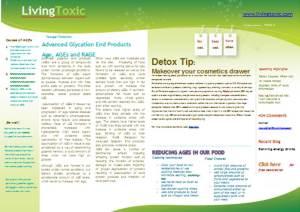What is risk and what makes us run to the overpriced spas and the vitamin stores in a desperate attempt to purge the “toxins” in our body. The bottom line is that its fear and with fear, the ability to make rational decisions is limited.
Consider the following points on Risk (Schneier, 2003: Beyond Fear):
- People exaggerate spectacular but rare risks and downplay common risks. They worry more about earthquakes than they do about slipping on the bathroom floor, even though the latter kills far more people than the former.
- People have trouble estimating risks for anything not exactly like their normal situation. Americans worry more about the risk of mugging in a foreign city, no matter how much safer it might be than where they live back home.
- Personified risks are perceived to be greater than anonymous risks. Display a few innocent children being poisoned by money hungry capitalists who don’t care about toxic chemicals in children products and there is a major uproar
- People underestimate risks they willingly take and overestimate risks in situations they can’t control. When people voluntarily take a risk, they tend to underestimate it. When they have no choice but to take the risk, they tend to overestimate it.
- Similarly, people overestimate even more those risks that they can’t control but think they, or someone, should. While we can’t really prevent criminals like the two snipers who terrorized the Washington, DC, area in the fall of 2002 from killing, most people think we should be able to.
- Last, people overestimate risks that are being talked about and remain an object of public scrutiny.
As listed above, we are more apt to perceive a unique, unfamiliar threat that we have very little control off as being high on the list of toxic things causing our health deterioration vs a familiar common risk that we may perceive as one which we can somehow control. This brings me to the idea that the common populace is typically uninformed or incorrectly informed with respect to toxicological risk. Take for instance the recent issue with BPA shown in various studies to have reproductive effects even when given is really small doses in infants. This had environmental groups and the general population in an uproar with strong accusations flung at the regulatory agencies that likely did not have adequate data to have made informed decisions. I may be an optimist but the evaluation of risk is not an exact science, regulatory agency are not out to injure people and issues such as miscalculation of BPA risk may be one of many steps in reassessment of how risk is evaluated. So a positive outcome is served. For BPA, parents may have little control over their children’s exposure. No manufacturers are going to advertise in bold red letters “contains BPA: may be harmful to your children” on baby bottles. This leaves the decision to the consumer and in almost all cases, consumers are not all well informed so there is less potential to avoid BPA –containing products. This brings us to the point. BPA is a unique risk, sensationalized by the media. Is that really the product of concern? How about a more common, lethal risk that we willingly expose our children to on a daily basis. Sugar. For a young child, feeding seems only attractive if there is sugar included somewhere – either as a prize after eating or as part of the meal, for example sugar frosted cornflakes or fruit loops or highly sugared ice cream. This is giving parents the benefit of the doubt that Twinkies would not even make this list. Anyone reading this article is likely not a person who feeds their family Twinkies. These are everyday risk that are responsible for the morbidity of a large number of people in the United States. Take diabetes for instance. Childhood diabetes is likely unrelated to toxic chemicals (as we know them, ie dioxins, PCBs etc). Rather, poor diets high in fats and sugars. I am constantly overwhelmed by the resistance to measures forcing children to eat less sugar such as taxing soft drinks, removing soda vending machines from school. These are commendable measures but not enough since these would need to be removed from the supermarkets as well as most parents provide this type of diet to their children. What kills most people? Dioxin or sugar? The answer would be sugar. Biggest killer in the USA is cardiovascular diseases. These are associated to a large part to diet. Second frequent killer is cancer. At least two third of cancers are a lot easier to prevent than we think. It is difficult to assess the contribution of environmental chemicals to the cancer death rate, the public has been working systematically to bring to light, all possible dangers – only of adequately sensationalized.
There is a lot of information that suggests that being fat and unhealthy makes the other risks factors worse. So how about we consider fixing those aspects we can control – such as dietary fats and sugars and continue public outcry on those that we have limited control over such as contamination of our environment.
What am I missing?
How many of the people munching on Twinkies and downing them with soda are worried about BPA in their diet? Not many, if I were to guess. However, consider then, the concerned parent who rightfully wants to make sure that the children are not exposed to more toxicants than they should. Here, is the level of concern regarding a proper diet higher on the list of concerns than the chemicals added to the food? The advocates for environmental toxification tend to be more vocal than the nutritionists.
Maybe that’s what needs to change. If dietary factors were corrected as quickly as BPA was taken out plastics, we could save at least 40% of the lives lost per year. That’s about 1 million people.



